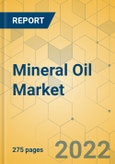Speak directly to the analyst to clarify any post sales queries you may have.
The global mineral oil market to grow at a CAGR of 3.9% during 2021-2027.
MINERAL OIL MARKET TRENDS AND OPPORTUNITIES
Growing demand from the pharmaceutical industry
Mineral oil is used in the pharmaceutical industry for specific formulations such as bulk drugs, lotions, ointments, laxatives, etc. In 2020, the pharmaceutical industry witnessed massive disruptions. The sector experienced a rise in demand for OTC medicines, antibiotics, flu-related medicines, and others. The major strategy undertaken by pharmaceutical drug companies was developing innovative products to meet varied consumer requirements. The industry is projected to witness significant growth in 2022 owing to diverse consumer needs and fluctuating industry demand. The rapid growth in the emerging market such as China, India, and Brazil, leading migration of R&D activities of various pharmaceutical companies to these fast-growing markets, is also expected to boost industry growth in the coming years.
Increasing demand for white oil
White oils are used in cosmetic and personal care products, from emulsions such as lip balm, baby oil, haircare, creams, and emollients. Diaper rash and eczema irritation can be relieved with white oil. Liquid paraffin is also widely used in the cosmetics business. White oil is utilized in hand and body care cosmetics at concentrations ranging from 1% to 99%, depending on the product quality required. White oil is also used in cosmetic lip care products. Growth in the personal care industry in Europe and North America provides an opportunity to increase the consumption of white mineral oil.
MINERAL OIL MARKET SEGMENTATION
In 2021, pharmaceutical was estimated as the largest end-use industry with 40.50% market share. Mineral oil is increasingly being used as laxative, IVF procedures, nasal sprays, vaccines, antibiotics, etc.in the pharmaceutical sector.
Mineral oil is a highly refined, retains moisture, and lightweight component. In the personal care industry, these are used in infant lotions, cold creams, ointments, and a variety of other cosmetic products. Personal care industry is the fastest growing segment projected at a CAGR of 4.25% during the forecast period.
White mineral oils accounted for 66.77% of the market share in 2021. These are highly used in formulations such as antibiotics, sunscreens, and baby oils etc. due to good lubrication property, moisture repelling property, and desirable skin affects.
The market is primarily driven by the rising demand for effective pharmaceutical products and multifunctional personal care components such as hair shampoos, skin care creams, sunscreens, hair conditioners, and other similar products.
Segmentation by Type
- Paraffinic Oil
- Naphthenic Oil
- Aromatic Oil
Segmentation by Grade
- Technical Oil
- White Oil
Segmentation by End-Use
- Personal Care
- Food and Beverages
- Industrial
- Pharmaceutical
- Other
GEOGRAPHICAL ANALYSIS
Emerging economies such as India, China, Indonesia, Malaysia, Thailand, Brazil, Argentina, and others are the major markets for mineral oil. Growing population, developing infrastructure, rising disposable incomes, growing middle class, and growing prevalence of chronic diseases are major factors for growth in the region.
Segmentation by Geography
- North America
- US
- Canada
- Europe
- Germany
- UK
- France
- Italy
- Spain
- APAC
- China
- India
- Japan
- South Korea
- Indonesia
- Latin America
- Brazil
- Mexico
- Middle East & Africa
- Saudi Arabia
- UAE
- South Africa
COMPETITIVE LANDSCAPE
Mineral oil is amongst the major segments of the lubricants industry. Major players in the segment include BP, ExxonMobil, Shell, Sinopec, Petro-Canada, and others operate through strategies such as expansion, acquisition, new product launch to further their reach in the market.
In 2021, pharmaceutical was estimated as the largest end-use industry with 40.50% market share. Mineral oil is increasingly being used as laxative, IVF procedures, nasal sprays, vaccines, antibiotics, etc.in the pharmaceutical sector.
Key Vendors
- British Petroleum
- ExxonMobil
- Petro-Canada
- Shell
- Sinopec
Other Prominent Vendors
- Addinol
- Amalie Oil
- BASF
- Chevron
- Clariant
- DOW
- Eastman
- Eneos
- Eni
- Fuchs
- Opet
- Radco
- Renkert Oil
- Rosneft
- Sasol
- Sonneborn
- Seojin Chemicals
- Suncor Energy
- Total Energies
- Unicorn Petroleum
THE REPORT INCLUDES:
1. The analysis of the global Mineral Oil market provides market size and growth rate for the forecast period 2022-2027.
2. It offers comprehensive insights into current industry trends, trend forecast, and growth drivers about the global Mineral Oil market.
3. The report provides the latest analysis of market share, growth drivers, challenges, and investment opportunities.
4. It offers a complete overview of market segments and the regional outlook of the Mineral Oil market.
5. The report offers a detailed overview of the vendor landscape, competitive analysis, and critical market strategies to gain competitive advantage.
Table of Contents
Companies Mentioned
- British Petroleum
- ExxonMobil
- Petro-Canada
- Shell
- Sinopec
- Addinol
- Amalie Oil
- BASF
- Chevron
- Clariant
- DOW
- Eastman
- Eneos
- Eni
- Fuchs
- Opet
- Radco
- Renkert Oil
- Rosneft
- Sasol
- Sonneborn
- Seojin Chemicals
- Suncor Energy
- Total Energies
- Unicorn Petroleum
Methodology
Our research comprises a mix of primary and secondary research. The secondary research sources that are typically referred to include, but are not limited to, company websites, annual reports, financial reports, company pipeline charts, broker reports, investor presentations and SEC filings, journals and conferences, internal proprietary databases, news articles, press releases, and webcasts specific to the companies operating in any given market.
Primary research involves email interactions with the industry participants across major geographies. The participants who typically take part in such a process include, but are not limited to, CEOs, VPs, business development managers, market intelligence managers, and national sales managers. We primarily rely on internal research work and internal databases that we have populated over the years. We cross-verify our secondary research findings with the primary respondents participating in the study.

LOADING...








